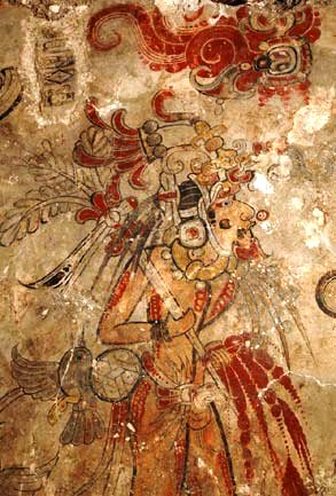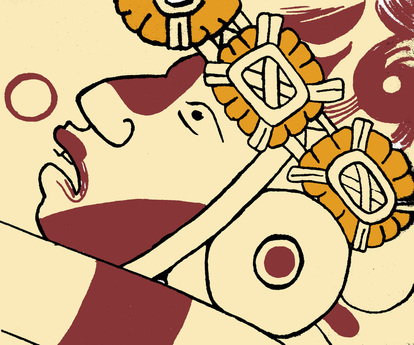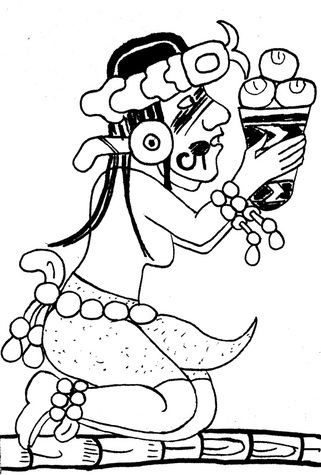|
Fifteen Years with the San Bartolo Mural Fifteen years ago, archaeologist William Saturno suffered the first symptoms of heat stroke as he crawled into a tunnel at San Bartolo, Guatemala. He was weak and dizzy, and he only picked the corridor to avoid the mean, brutal sun. His flashlight bounced over the walls of a looters trench, and all at once, he saw the tall, beautiful bodies of the Maya god of corn and his followers on their knees around him or carrying to him the sacrifices he required, hummingbirds and bees, babies emerging bloody with afterbirth from the world itself. We will probably never know the name of the artist who worked at San Bartolo. But we do know one thing: he or she was a master. The artist painted San Bartolo worked quickly to paint all four walls of the interior of the Pyramid of the Pictures. "Sometimes archaeologists have been able to detect drip lines on Preclassic painted monumental masks, where the artist was unable to control the flow of paint," David Freidel told National Geographic. "The San Bartolo mural was painted by a great master, with fine-line exquisite details all perfectly rendered." He (or she, but based on previous understandings of mural painters probably he) painted four walls with his own intricate representation of the culture and religion in which he lived. Like the Romans and Greeks, the Maya had constructed high standards of beauty and ideal form. But these specific elements to symbolize beauty often resulted in stilted, stiff figures with little dimension and serious, unemotive faces. In other cases, the most emotive Maya paintings portray the conquered, the prisoners of war who would go on to be killed for their crimes against the state in the name of the gods. Their eyes sometimes make contact with the viewer directly, while their conqueror stares off in an air of perfection and pride. San Bartolo is different. Here, admiration for the gods radiates from the faces of their worshipers. Here, gods jabbing knives into their own genitals to draw forth precious blood are bent at the waist with pain, and they don’t have the stoic faces of nobility conducting the same ceremony elsewhere. Here, blood is not portrayed euphemistically as serpents, but it is rich, gushing, and frequent. While the murals convey a number of ideas about the Maya cosmology, perhaps the most famous mural shows the Maize God, a figure which may represent his wife, and his followers, who offer tamales and mysterious bundles. Artist Heather Hearst has replicated this portion of the mural and posted it at PBS with explanations of the iconography archaeologists can identify. The Maize God and his wife aren’t just royalty. They’re something more than human. The Maize God himself projects wind from his open mouth. Maya women typically wore a long dress-like garment absent on the Maize God’s wife, and the sensual curves of both their bodies are unique in Maya muralism. At the later-era Bonampak mural, 700 years later, soldiers are arranged in precise symmetrical lines around kings and priests. These soldiers are all close to each other, but none stands so close to the leaders. The worshipers around the Maize Gods are stacked on top of each other, probably to imply depth, perhaps symbolizing the petitioners’ desire to be close to this figure. One petitioner’s toe almost touches the god. Yet in other ways, the Maize God knows the pain of life and death. He is four heads tall, as is his wife. The kneeling figures also appear to be about four heads tall, meaning he does not tower above them as some figures at Teotihuacan do. Nay, their god is among them. He is one of them. And, like them, like us, he will die. The Maize God needs to die, or he can’t be reborn next year, and he can’t feed the people next year. Without his sacrifice, we would all be lost. It’s a difficult sacrifice, but it’s one the Maya desired to emulate. If the gods would die for us, why shouldn’t we die for them? We eat of the earth, and the earth eats us. While many of the elements of the San Bartolo mural reflect typical Maya myth, the variation on themes is impressive—and it creates new questions. The mural features Maya writing, but it is of such an early age that it doesn’t look like the writing epigraphers are used to seeing. Arguably the world’s best Maya epigrapher, David Stuart, has tentatively identified a few glyphs, but whether they represent the names of the individuals featured on the mural, the contents of the mysterious bundles carried by the standing black and red figures, or a record of a ceremony of some sort, he doesn’t know. Zach Lindsey Zach Lindsey is a student of anthropology and an English as a Second Language teacher. He fell in love with art history after reading Elie Faure’s books. You can view his website at http://arqueogato.tumblr.com, but it’s mostly just an eclectic collection of pictures of art and architecture he’s taken, so he’s not sure if you really want to.
0 Comments
Your comment will be posted after it is approved.
Leave a Reply. |
The Ekphrastic Review
COOKIES/PRIVACY
This site uses cookies to deliver your best navigation experience this time and next. Continuing here means you consent to cookies. Thank you. Join us on Facebook:
July 2024
|






